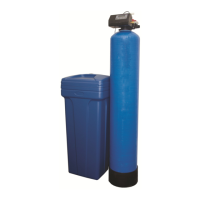Why is my Rainfresh 30TFM salt use so high?
- MMary ThomasAug 17, 2025
High salt use in your Rainfresh Water Dispenser might be due to the refill time being too high. To resolve this, correct the brine refill settings according to table 1.

Why is my Rainfresh 30TFM salt use so high?
High salt use in your Rainfresh Water Dispenser might be due to the refill time being too high. To resolve this, correct the brine refill settings according to table 1.
How to fix low water pressure in my Rainfresh Water Dispenser?
Low water pressure in your Rainfresh Water Dispenser could be caused by: * Iron or scale buildup in the supply line. Clean or replace the supply line. * Iron buildup inside the valve or tank. Clean the control valve, add resin cleaner, and increase regeneration frequency. * A plugged control valve inlet. Clean the control valve inlet.
What to do if my Rainfresh 30TFM Water Dispenser display screen is blank?
If the display screen on your Rainfresh Water Dispenser is blank: * Ensure the power cord is properly connected to both the adapter and the receptacle, and reconnect if necessary. * If the issue persists, the circuit board may be defective.
Why is there too much water in the brine tank of my Rainfresh Water Dispenser?
Too much water in the brine tank of your Rainfresh Water Dispenser can be due to: * A plugged injector or screen. Clean these parts. * A plugged brine valve. Clean the parts. * A plugged DLFC. Clean the DLFC.
What to do if my Rainfresh Water Dispenser unit fails to draw brine?
If your Rainfresh Water Dispenser fails to draw brine, consider the following: * The DLFC might be plugged, so clean the DLFC. * The injector or screen could be plugged; clean these parts. * The inlet pressure might be too low; increase the minimum pressure to at least 25 psi. * There could be an internal valve leak; replace the seals, spacer, and piston assembly.
Why does my Rainfresh Water Dispenser unit fail to start a regeneration cycle?
If your Rainfresh Water Dispenser fails to start a regeneration cycle, it could be due to: * No power supply. Check the electrical service and reset the time of day. * A defective circuit board. Replace the faulty parts.
Why is there resin in the drain line of my Rainfresh Water Dispenser?
Resin in the drain line of your Rainfresh Water Dispenser may be caused by: * Air in the water system. Check the well system for proper air elimination. * An incorrect or missing drain line flow control (DLFC). Check and replace the DLFC.
What causes continuous cycling in a Rainfresh 30TFM Water Dispenser unit?
Continuous cycling in your Rainfresh Water Dispenser unit may be caused by a defective circuit board. If this is the case, replace the faulty parts.
What to do if the Rainfresh 30TFM Water Dispenser softened water is still hard?
If the softened water from your Rainfresh Water Dispenser is still hard, here are a few possible causes and solutions: * Ensure the bypass valve is open. * Add salt to the salt tank if it's empty. * Check for a leak between the valve and riser tube. If the riser is cracked or the O-ring is damaged, replace the faulty parts. * The injector/screen may be plugged; clean these parts. * The brine refill settings might be wrong; correct them according to Table 1. * There may be an internal valve leak; replace the valve seals, spacer, and piston assembly.
What causes water to flow to the drain continuously in my Rainfresh 30TFM?
Continuous water flow to the drain in your Rainfresh Water Dispenser can be caused by: * Incorrect valve settings. Check the valve settings. * An internal leak. Replace the seals, spacer, and piston assembly.
| Brand | Rainfresh |
|---|---|
| Model | 30TFM |
| Category | Water Dispenser |
| Language | English |
Details required water quality parameters for optimal softener performance.
Explains the ion exchange process used by the softener to remove hardness minerals.
Outlines essential safety measures to follow when operating and maintaining the water softener.
Provides critical warnings and advice before proceeding with the softener installation.
Specifies the power supply needs and recommendations for connecting the water softener.
Guides the user through the process of safely removing the softener and its components from the packaging.
Details the steps for connecting the water softener to the household plumbing system.
Guides the user through the initial setup and programming of the water softener's control valve.
Step-by-step instructions for setting the current time on the softener's control unit.
Step-by-step instructions for setting the current date on the softener's control unit.
Instructions for inputting the number of household occupants for optimal softener operation.
Guide on how to determine and input the water hardness level for accurate softening.
Instructions on how to activate vacation mode for extended periods of non-use.
Details various programmable parameters and their default settings for advanced configuration.
Procedure for disinfecting the water softener unit prior to or after installation.
Instructions on how to manually initiate the regeneration cycle for the water softener.
Explains how the unit's programmed settings are retained and managed during power interruptions.
Describes the safety float mechanism designed to prevent brine tank overfilling.
Informs the user about normal operating sounds, particularly during the regeneration cycle.
Details how to use the bypass valve to isolate the softener during emergencies.
Guidance on the correct type and method for adding salt to the softener's brine tank.
Explains how to identify and resolve salt bridging issues within the brine tank.
Recommendations for cleaning and maintaining the external appearance of the water softener.
Instructions for cleaning the injector assembly to ensure proper operation and flow.
